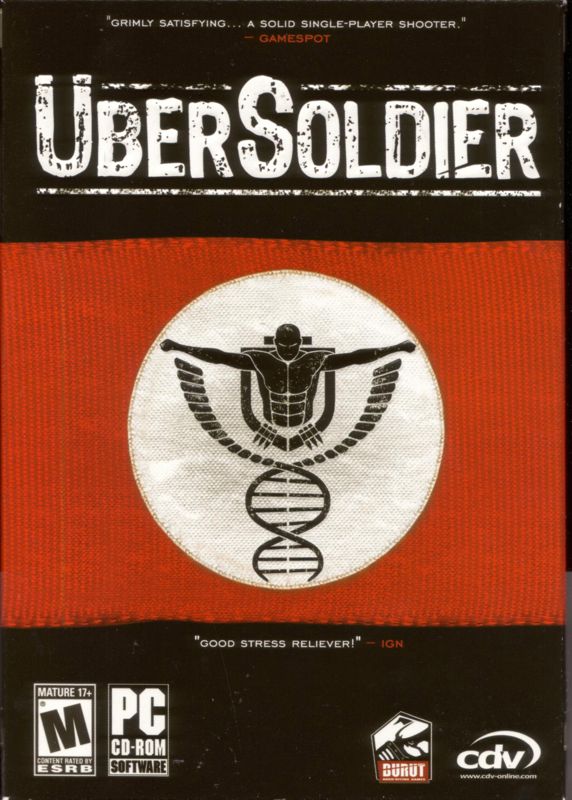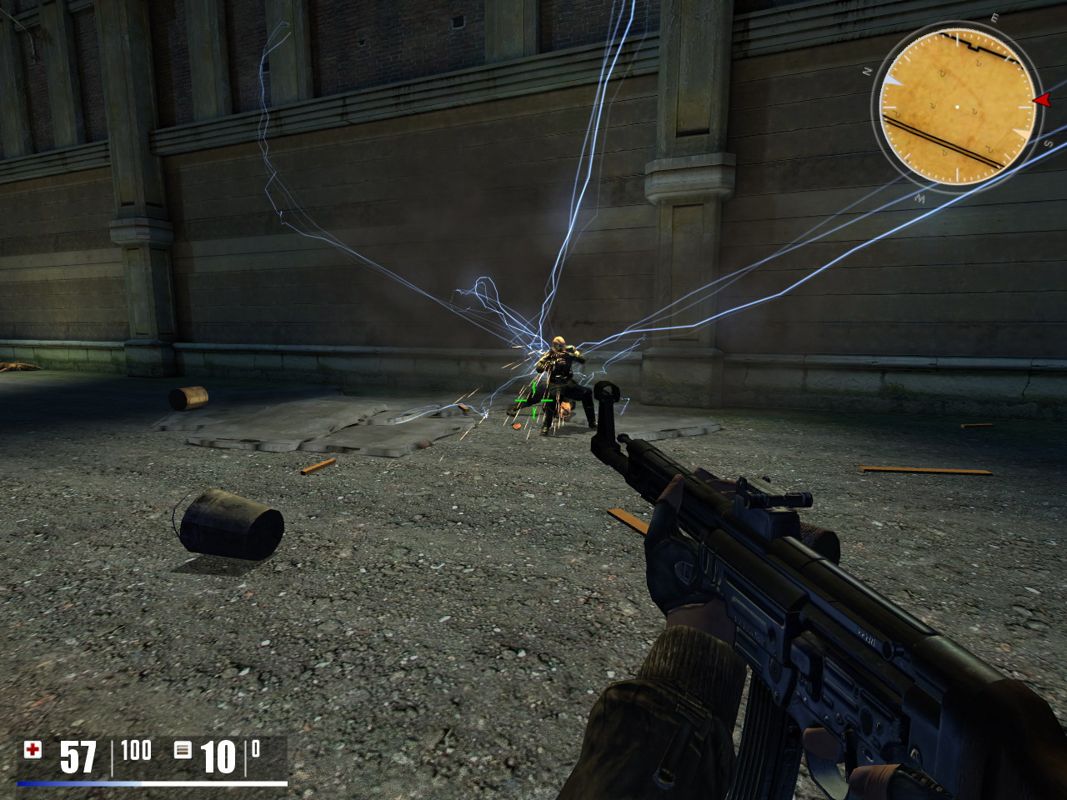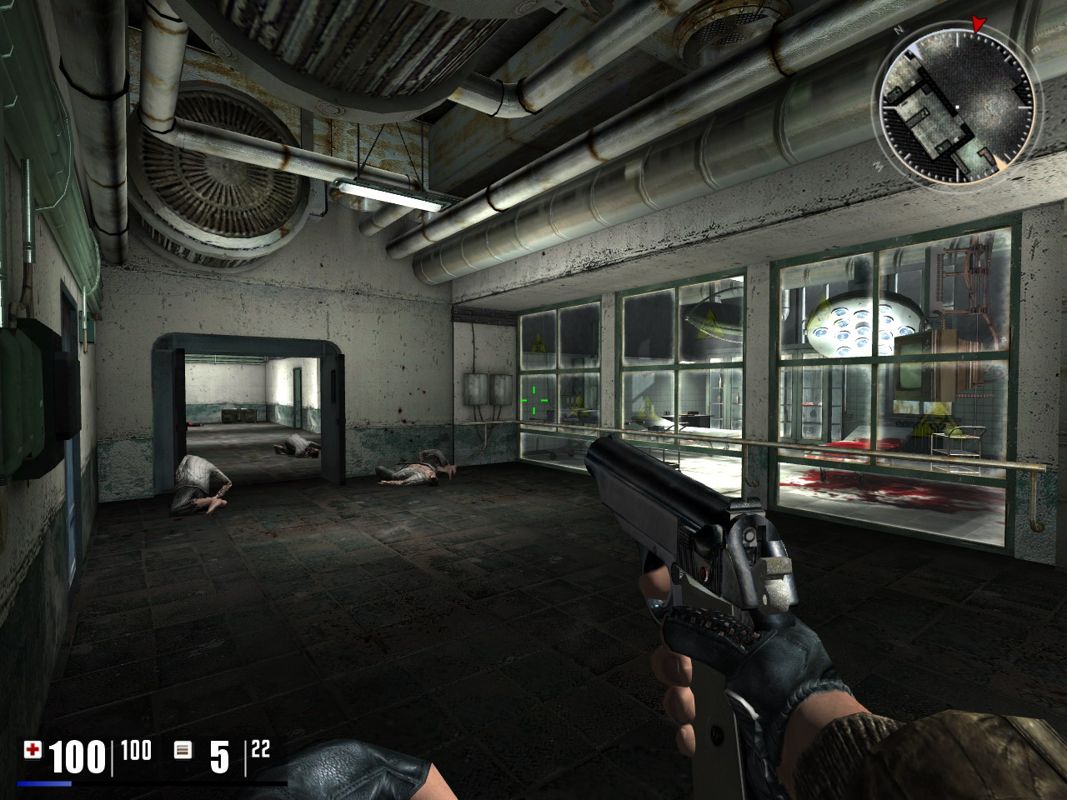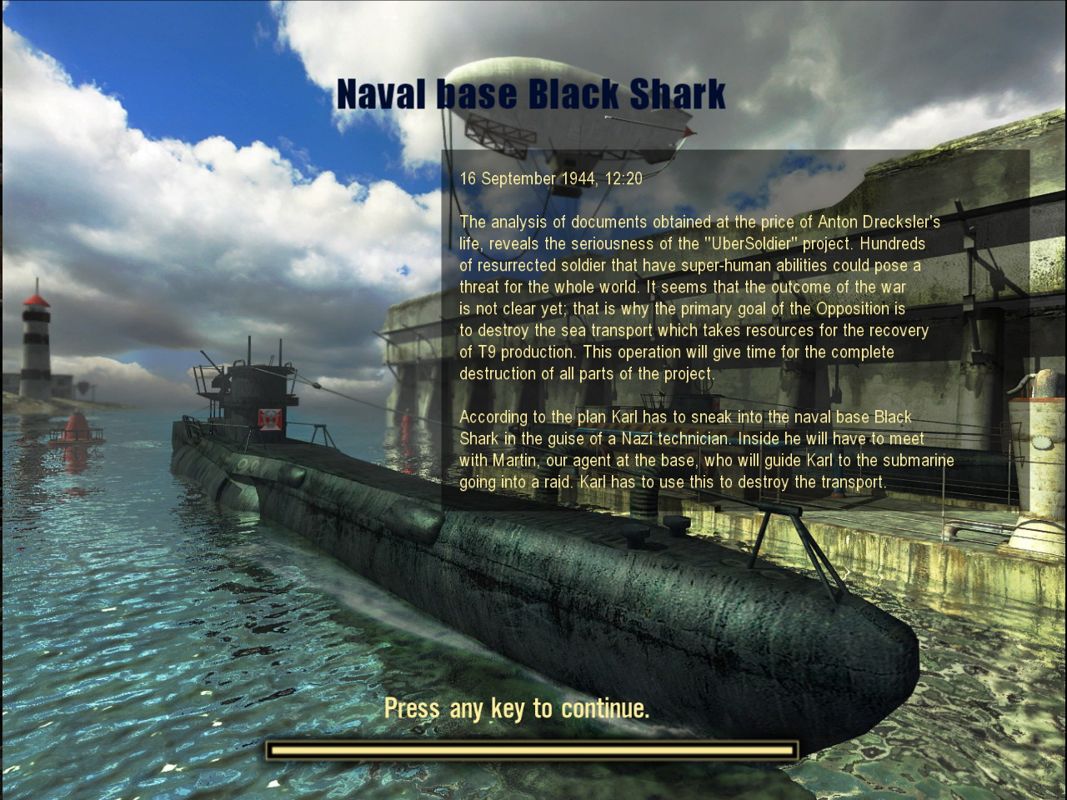Retro Replay Review
Gameplay
ÜberSoldier delivers a classic run-and-gun first-person shooter experience set against the backdrop of World War II. Players step into the boots of Karl Stoltz, a once-German officer who has been resurrected as a super-soldier and now fights for the Allies. The core combat loop is straightforward: navigate linear combat arenas, dispatch waves of Axis troops, and make strategic use of Stoltz’s unique “ÜberPowers” to push through increasingly intense firefights.
(HEY YOU!! We hope you enjoy! We try not to run ads. So basically, this is a very expensive hobby running this site. Please consider joining us for updates, forums, and more. Network w/ us to make some cash or friends while retro gaming, and you can win some free retro games for posting. Okay, carry on 👍)
The weapon system is both familiar and functional. You carry five slots—pistol, rifle, machine gun, rocket launcher, and grenades—and must manage your loadout on the fly. If you encounter a duplicate weapon, you’ll need to swap it with your current gear via the use button, making every ammunition pickup and weapon cache a small tactical decision. A persistent heads-up display shows which weapon occupies each slot, ensuring you never fumble for the right firepower when the bullets start flying.
What sets ÜberSoldier apart is the integration of supernatural abilities. Landing headshots charges a bullet shield that grants temporary invulnerability, while slashing enemies in the head with your knife replenishes health. These mechanics encourage an aggressive playstyle, rewarding precision and mobility. You’ll find yourself juggling gunplay and melee to maintain your survivability, especially in later levels where hoards of undead super-soldiers converge.
Enemy design and AI behavior keep encounters engaging. Standard soldiers, armoured ÜberSoldiers, and boss-type foes require different approaches: standard units can be suppressed by concentrated fire, while tougher opponents demand use of your special powers to break through. Level layouts blend tight corridors with occasional open courtyards, giving moments of claustrophobic tension followed by brief respites where you can plan your next assault.
Graphics
ÜberSoldier runs on a mid-2000s engine that, while not revolutionary today, still manages to evoke the grim atmosphere of World War II battlegrounds. Outdoor environments—French farmlands, ruined villages, frozen forests—are rendered with muted color palettes and weathered textures that convey war-torn desolation. Indoor sequences, particularly the creepy underground Nazi labs, employ dim lighting and ominous corridors to ramp up tension.
Character models range from generic foot soldiers to towering ÜberSoldiers, each with distinctive armor plating and glowing artifacts. Animations are serviceable: reloads and melee swings are smooth, though occasional clipping can occur when bodies collapse or weapons intersect geometry. Facial animations during cutscenes are more static but offset by moody camera angles and voiceover work that injects emotion into Stoltz’s quest for vengeance.
Special effects are a highlight. The bullet shield manifests as a shimmering, translucent dome that warps light and crackles with energy whenever activated. Knife slashes produce satisfyingly gory decals, and explosions kick up dust and debris that linger in the air. Particle effects for gunfire, smoke, and sparks are plentiful, though prolonged firefights can lead to frame-rate dips on lower-end hardware.
Performance overall is stable on mid-range PCs, provided you dial back a few graphics settings. Loading times between levels are reasonable, and texture pop-in is minimal. If you enjoy tweaking detail levels, you can find a balance between visual fidelity and smooth frame rates, ensuring the action remains fast and fluid.
Story
The narrative premise of ÜberSoldier is a fresh twist on the typical WWII shooter. By introducing an ancient Tibetan resurrection technique, the game blends historical fiction with supernatural thriller elements. You play as Karl Stoltz, betrayed and reborn, who now wields his newfound powers against the very regime that created him. This inversion of allegiance provides a personal motive that drives the campaign forward.
Story progression is delivered through a mix of in-engine cutscenes and brief text interludes. While the dialogue can be blunt—soldiers shout orders, scientists bark directives—it successfully conveys urgency and high stakes. As Stoltz learns more about the Nazi experiments, you witness moral conflicts and the sheer horror of resurrecting the dead, lending weight to your mission beyond simple bullet counts.
Level objectives are woven into the storyline: infiltrate labs, sabotage production lines, rescue captured Allies, and ultimately confront the mastermind behind the ÜberSoldier program. Each mission builds on the last, escalating both the supernatural threat and the emotional resonance of Stoltz’s journey. Although the plot occasionally leans on familiar WWII tropes, the resurrection angle keeps it feeling novel.
Voice acting is competent, if not Oscar-worthy. The gruff timbre of German officers and the hurried accents of French Resistance fighters feel authentic enough to immerse you in wartime Europe. Occasional translation quirks add unintended charm, reminding players that this is a European-developed title with a distinct tone.
Overall Experience
ÜberSoldier offers a satisfying blend of classic FPS mechanics and supernatural powers, set within a grim World War II milieu. Its combat is relentless, encouraging both precision headshots and aggressive melee play. The weapon management and power-charging systems provide depth that keeps firefights from growing repetitive, even as the linear level design marches you from one shootout to the next.
Graphically, the game holds up reasonably well for its age. While not on par with modern engines, its environments and effects effectively convey a dark, war-scarred world. Performance is stable with minor tweaks, and the special effects for shields and wounds add flair to every skirmish. Audio design, from gunfire to ambient music cues, complements the visuals and maintains immersion.
The storyline, anchored by Karl Stoltz’s revenge arc, introduces an inventive resurrection concept that differentiates ÜberSoldier from other WWII shooters. Though the narrative delivery is straightforward, it provides enough context and motivation to keep players engaged through ten or so hours of gameplay. The voice work and cutscenes, while functional, serve the plot without overindulging in exposition.
For fans of vintage FPS titles who crave an alternative to grim military simulators, ÜberSoldier is a worthy detour. Its blend of supernatural powers, run-and-gun action, and historical setting makes for an entertaining ride. If linear campaigns, headshot-focused combat, and occasional frame-rate hitches don’t deter you, ÜberSoldier delivers a memorable experience that stands out in the crowded WWII shooter genre.
 Retro Replay Retro Replay gaming reviews, news, emulation, geek stuff and more!
Retro Replay Retro Replay gaming reviews, news, emulation, geek stuff and more!









Reviews
There are no reviews yet.